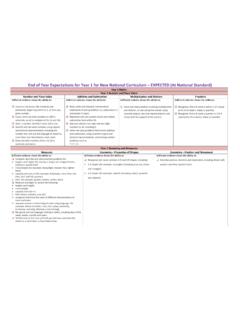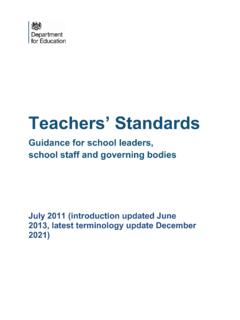Transcription of End of Year Expectations for Year 2 for New National ...
1 End of year Expectations for year 2 for New National curriculum expected (At National Standard) year 2 Maths year 2 Number and Place Value Number and Place Value Addition and Subtraction Multiplication and Division Fractions Sufficient evidence shows the ability to: Count in steps of 2, 3, and 5 from 0, and in tens from any number, forward and backward. Recognise the place value of each digit in a two-digit number (tens, ones). Identify, represent and estimate numbers using different representations, including the number line. Compare and order numbers from 0 up to 100; use <, > and = signs. Read and write numbers to at least 100 in numerals and in words. Use place value and number facts to solve problems. Sufficient evidence shows the ability to: Solve problems with addition and subtraction: using concrete objects and pictorial representations, including those involving numbers, quantities and measures applying their increasing knowledge of mental and written methods.
2 Recall and use addition and subtraction facts to 20 fluently, and derive and use related facts up to 100. Add and subtract numbers using concrete objects, pictorial representations, and mentally, including: a two-digit number and ones, a two-digit number and tens, two two-digit numbers. Add three one-digit numbers. Show that addition of two numbers can be done in any order (commutative) and subtraction of one number from another cannot. Recognise and use the inverse relationship between addition and subtraction and use this to check calculations and solve missing number problems. Sufficient evidence shows the ability to: Recall and use multiplication and division facts for the 2, 5 and 10 multiplication tables, including recognising odd and even numbers. Calculate mathematical statements for multiplication and division within the multiplication tables and write them using the multiplication ( ), division ( ) and equals (=) signs.
3 Show that multiplication of two numbers can be done in any order (commutative) and division of one number by another cannot. Solve problems involving multiplication and division, using materials, arrays, repeated addition, mental methods, and multiplication and division facts, including problems in contexts. Sufficient evidence shows the ability to: Recognise, find, name and write fractions 1/2, 1/3, 1/4, 2/4, 3/4 of a length, shape, set of objects or quantity. Write simple fractions for example, 1/2 of 6 = 3 and recognise the equivalence of 2/4 and . year 2 Geometry and Measures Measures Geometry Properties of Shapes Geometry Position and Movement Statistics Sufficient evidence shows the ability to: Choose and use appropriate standard units to estimate and measure length/height in any direction (m/cm); mass (kg/g); temperature ( C); capacity (litres/ml) to the nearest appropriate unit, using rulers, scales, thermometers and measuring vessels.
4 Compare and order lengths, mass, volume/capacity and record the results using >, < and =. Recognise and use symbols for pounds ( ) and pence (p); combine amounts to make a particular value Find different combinations of coins that equal the same amounts of money. Solve simple problems in a practical context involving addition and subtraction of money of the same unit, including giving change. Compare and sequence intervals of time. Tell and write the time to five minutes, including quarter past/to the hour and draw the hands on a clock face to show these times. Know the number of minutes in an hour and the number of hours in a day. Sufficient evidence shows the ability to: Identify and describe the properties of 2-D shapes, including the number of sides and line symmetry in a vertical line. Identify and describe the properties of 3-D shapes, including the number of edges, vertices and faces.
5 Identify 2-D shapes on the surface of 3-D shapes, [for example, a circle on a cylinder and a triangle on a pyramid]. Compare and sort common 2-D and 3-D shapes and everyday objects. Sufficient evidence shows the ability to: Order and arrange combinations of mathematical objects in patterns and sequences. Use mathematical vocabulary to describe position, direction and movement, including movement in a straight line and distinguishing between rotation as a turn and in terms of right angles for quarter, half and three-quarter turns (clockwise and anticlockwise). Sufficient evidence shows the ability to: Interpret and construct simple pictograms, tally charts, block diagrams and simple tables. Ask and answer simple questions by counting the number of objects in each category and sorting the categories by quantity. Ask and answer questions about totalling and comparing categorical data.
6 year 2 Reading Word Reading Comprehension Sufficient evidence shows the ability Apply phonic knowledge and skills consistently to decode quickly and accurately. Decode alternative sounds for graphemes. Read words containing common suffixes such as: -ment, -less, -ness, -ful and ly. Read a wider range of common exception words which have been taught, including most words from the YR 2 spelling appendix because, beautiful, everybody, should, whole, parents, money. Read most words without overtly segmenting and blending, once they are familiar. Read some phonically-decodable books with fluency, sound out unfamiliar words automatically. Sufficient evidence shows the ability Fully engage with reading and take pleasure from books and texts. Listen to, discuss and express views about a wide range of contemporary and classic poetry, some of which they can read independently.
7 Listen to, discuss and express views about a wide range of stories at a level beyond that which they can read independently. Takes account of what others say. Show understanding of texts read independently; self-correct. Know and retell a wide range of stories, fairy stories and traditional tales. Discuss the sequence of events in books, and how items of information are related. Make inferences on the basis of what is said and done; predict according to what has been read so far. Discuss and express views about a range of non-fiction texts which are structured in different ways. Discuss and clarify the meaning of new words; discuss favourite words and phrases. Recognise simple recurring literary language in stories and poetry. Recite a repertoire of poems learnt by heart, using appropriate intonation. year 2 Writing Transcription Composition Spelling Sufficient evidence shows the ability Write from memory, simple dictated sentences which include familiar words and GPCs.
8 Spell common decodable two and three syllable words which include familiar graphemes. Accurately spell words with suffixes ment, -ness, -ful, -less, -ly, including those requiring a change to the root word. Spell most common exception words from Y2 spelling appendix because, every, children, father, would, old. Spell most common homophones in YR 2 spelling appendix to, too, two; hear, here; see, sea; blue, blew. Spell many common contractions accurately it s, can t, didn t; or to mark singular possession Mark s football. Handwriting Evidence: Holds pencil correctly. Writing is legible. All letters and digits are consistently formed and of the correct size, orientation and relationship to one another. Spacing is appropriate to the size of letters. Some letters are joined correctly, according to the school s handwriting approach.
9 Composition: structure and purpose Sufficient evidence shows the ability Compose sentences orally. Use the drafting process to gather and write down ideas and key words. Write appropriate narratives about personal experiences or those of others, whether real or imagined, maintaining narrative form. Write about real events, maintaining form and purpose. Compose orally and write poetry in a variety of forms. Re-read and check own writing. Proof read for errors. Evaluate word choice, grammar and punctuation; make revisions. Vocabulary, grammar, punctuation Sufficient evidence shows the ability Write a range of sentence types which are grammatically accurate commands, questions and statements. Co-ordinate sentences using and, or, but. Sometimes use subordination when, if, because. Use sentence demarcation with increasing accuracy, including capital letters, full stops, question marks and exclamation marks; commas to separate items in lists.
10 Use some varied vocabulary to create detail and interest, including adjectives to make noun phrases; adverbs and verbs. Identify word classes: noun, adjective, verb and adverb. Choose the past or present tense appropriately. Experiment with the progressive form she was swimming. Use appropriate features of Standard English.




